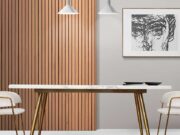Samsung Music Frame
MSRP $399.99
“The Music Frame makes powerful, full-range sound become a seamless part of your decor.”
Pros
- You’d never know it’s a speaker
- Incredibly powerful
- Surprising bass response
- Swappable, customizable art
- Hi-res audio and Dolby Atmos
Cons
- Some distortion of extreme lows
- Controls can be awkward
- Atmos volume levels are too low
We’ve been trying to make speakers disappear for decades. Most of these attempts involve tricky in-wall or in-ceiling installations. Some take a sneakier route like sticking a speaker behind a houseplant or under a piece of furniture. Recently, however, we’ve seen a new tactic in the invisible speaker battle: building high-quality speakers into everyday objects. Largely thanks to Ikea’s collaboration with Sonos, wireless speakers are now disguised as table lamps, shelves, and even wall art.
The most recent — and I’d argue the most successful — of these camouflaged speakers so far is Samsung’s Music Frame ($399).
It looks exactly like a photo frame, albeit a big, thick one. Unless you poked your nose around the back and noticed the two large subwoofers, you’d never know that lurking under the surface is a very potent wireless speaker.
Speaker? What speaker?

I have to commend Samsung on the design. With its thin, black bezels, hidden controls, and simple yet elegant off-white image matte, the Music Frame looks great almost anywhere you place it — that’s a distinct advantage given that it’s also a speaker. If you prefer a lighter look, Samsung sells a white bezel that magnetically latches to the Frame’s sides.
The matte, which Samsung calls the photo frame, is removable, and you’ll need to remove it if you want to swap out the stock turntable graphic. It’s held in place — very firmly — by four ball-and-socket posts. Prying the photo frame free isn’t as easy as Samsung’s instructions suggest. Some kind of plastic pry tool would have been a nice inclusion; the gap between the frame and the speaker’s bezel is smaller than my fingers.
Pro tip No. 1: Don’t try to remove the photo frame with the speaker standing up. Remove the stand, then lie the speaker flat. Don’t make me go into details. Mistakes were made.

Once the frame is off, there’s a removable plastic panel that gives you access to the print.
Samsung says you can insert either an 8×10 or 8×8 print, but that’s just part of the story. If you choose an 8×10, the square shape of the matte cutout means you’ll only see the central 8×8 portion. That’ll probably be OK for most portraits, but landscapes may feel overly cropped.
If you choose an 8×8, I’m not super confident that it won’t slide around in the larger space.
Pro Tip No. 2: Orient your 8×8 so that the holder grooves are at the top and bottom, not the sides. This should keep movement to a minimum.

The photo frame’s plastic glazing has an anti-glare finish. It does a good job of cutting down on reflections, but it also dulls the look of your photos.
If you don’t like it, you might want to take advantage of the Music Frame’s art panel option. I’ve found a couple of companies that will print a full-bleed, high-gloss panel that’s compatible with the speaker for about $60. They ship you just the panel. Your job is to attach the included ball-and-socket posts so you can mount the panel to the frame. You get four posts in the box and I’m trying to find out where you can buy more if you need them.
Samsung sent me a sample art panel along with the speaker. I’m not a dog person, but it looks really sharp. I can totally see people printing a few seasonal art panels and swapping them in as part of their decor instead of family photos.

Samsung Music Frame specs
| Price | $400 |
| Color | Black (with optional white bezels) |
| Speakers | 6 |
| Inputs | Optical, Wi-Fi, Bluetooth |
| Audio formats | Dolby Atmos, MP3, AAC, OGG, FLAC, WAV, ALAC, AIFF |
| Bluetooth codecs | SBC, SSC (Samsung Seamless) |
| Wireless music | Spotify Connect, Apple AirPlay 2, Bluetooth, Tidal Connect, Google Cast |
| Spatial audio | Dolby Atmos (only with Samsung TVs), Dolby Atmos Music |
The Music Frame goes anywhere

The stand easily snaps into the bottom of the frame and provides a very solid base. The sheer weight of the frame (about 9 pounds) is enough to keep it steady, but I would still be careful to place it somewhere out of reach of toddlers. The edges and corners are hard and pointy — if this thing fell on a little one (or even a pet), it might cause serious injury.
Ordinarily, I dislike external power adapters on speakers. I think they’re ugly and I don’t like having to hide them. The Music Frame’s adapter is fairly small compared to many others, but the reason I’m OK with it is that it lets Samsung use a very thin and light visible cable, while the heavier, black power cord and adapter can be tucked away. Samsung uses the same clever trick on its The Frame TV.
The power cord was one of my biggest critiques of the Ikea/Sonos Symfonisk Picture Frame. Its power cord uses a fabric wrap to soften its look, but it’s still very thick and thus very noticeable, especially when wall-mounted.
The Music Frame’s cord is also noticeable (I’m not going to pretend it’s invisible), but it’s much easier to ignore, particularly if you place it on a light-colored wall.
Speaking of wall mounting, Samsung includes wall-mount hardware in the box, along with a template for installing it. I did not test it, because it involves drilling two holes and, while my wife has been patient with my choice of career, there are limits.
Pro Tip No. 3: Samsung doesn’t do a good job of promoting it, but you can buy a 115-inch in-wall-rated power cord for the Music Frame. It’s $50 and well worth it if you want a super-clean, wall-mounted installation. Check with your local building code, but my guess is it wouldn’t recommend using the included power cord for in-wall applications.
Controls and setup

As I said earlier, the hidden controls help preserve the look of an authentic photo frame. Unfortunately, that also makes them hard to see — especially if you wall-mount the speaker.
You get a multifunction button that wakes the frame from standby and lets you switch sources (Bluetooth/Wi-Fi/optical), volume up/down buttons, and an onboard mic on/off control. What you don’t get is any way to play/pause — a bizarre omission given the near universality of play/pause controls on both Wi-Fi and Bluetooth speakers.

I’m perplexed by Samsung’s choice of ports on the Music Frame. Having an optical input is handy for both TV and audio gear connections, but Samsung’s decision not to include an HDMI ARC/eARC means you can’t use the Frame as a Dolby Atmos soundbar alternative (optical connections aren’t Dolby Atmos-compatible).
If Samsung felt the Music Frame wouldn’t be a good match for this scenario, then the lack of HDMI might make sense, but the opposite seems to be true: The Music Frame can receive Dolby Atmos from a TV, but only via Wi-Fi, and only from a compatible Samsung TV.
Out of the box, you can use the Music Frame with the optical input or in Bluetooth mode. But to get the most out of the speaker, you need the free Samsung SmartThings mobile app. The app is the only way to access the sound modes (including EQ adjustments), and it also gets the Frame connected to your Wi-Fi network. Once that step is complete, you’ll be able to use Apple AirPlay 2, Google Cast (formerly Chromecast), Tidal Connect, and Spotify Connect — each of which offers advantages over Bluetooth. You can even enable Amazon Alexa to turn the Frame into a smart speaker.
If you end up owning multiple SmartThings-compatible Samsung speakers, the app lets you control them all from a single interface. If your home includes non-Samsung wireless speakers, it will likely be easier to use Google Home (via Google Cast), Apple Home (via AirPlay 2), or Amazon Alexa as your multiroom controllers.
I’m not thrilled that the SmartThings app forces you to create a Samsung account (or use an existing one to log in), but sadly, this has become very common.
Powerful sound

The first time I fired up the Music Frame, I was stunned by its power. At just 18% on the volume scale, it’s loud enough to make conversations challenging, and once it got to 35%, I was well beyond my ability to listen comfortably.
With its out-of-the-box tuning, the sound signature leans heavily toward boosted highs and lows. Some people like that balance, but if it’s not your cup of audio tea, there are several ways to change it.
Your first stop should be the Sound Mode setting in the SmartThings app. The three selections (Standard, Music, and Adaptive Sound) each act as a type of EQ preset. Standard is the most neutral, Music uses small amounts of boost in the lows and high, and Adaptive Sound is the most aggressive. It introduces noticeable amounts of processing, which you may be OK with given its ultrawide sound field effect.
If you want maximum control, pick Standard. When you jump into the app’s equalizer section, Standard gives you a seven-band equalizer (along with four presets). Music and Adaptive Sound only offer bass and treble adjustments.
After trying various combinations, I settled on Music mode, with the treble adjustment set to minimum and the bass set to a small amount of boost. This gave me the warmth and resonance I like while keeping the highs from becoming too piercing, which they tend to do when using the default settings.
I also used Samsung’s SpaceFit Sound continuously. On paper, Samsung says this feature uses the onboard mic to do automatic room tuning. In practice, I found that it only affected vocals. When turned off, vocals sounded thin and brittle, but when it was on, they regained their normal weight and warmth.
Speaker placement is always going to affect sound quality, but this is especially true with the Music Frame. It can create a surprisingly wide soundstage (especially when playing Atmos Music), but the effect is highly directional. If you think of the speaker as a spotlight with a fairly narrow beam, you want to be in the beam of light to get the best sound. Inside that beam, stereo separation is impressive for a single speaker. Step outside it and you’ll notice an immediate drop in fidelity.
Because of this, the Music Frame is going to be better for larger rooms where you can place the speaker near a corner and angle it into the room. If you put it on a wall, a central location will be better than one that’s off to the side. Be careful not to mount it too high: the ideal spot for listening is going to be slightly lower than ear level.
Dolby Atmos Music (available over Wi-Fi when using Amazon Music via Google Cast or Tidal Connect) can sound really good. It still very much depends on the track’s Atmos mix itself, but when you get a good one, like The Doors’ Riders On The Storm or M.I.A.’s Marigold, that extra level of immersion and height can be truly appreciated. It’s not as impressive as the $449 Sonos Era 300, which is one of the only other wireless speakers that can do Atmos), but then again, the Era 300 doesn’t exactly blend with the decor.
You’re going to need to keep careful tabs on the volume level when playing Atmos. A comfortable listening volume for stereo tracks is far too quiet for Atmos. I had to bump from 19 to 33 to get the same listening level for Atmos tracks — and this was true of every Atmos song I played.
This shouldn’t be necessary, but more annoying is the way volume works on the Frame in general.

Third-party apps like Apple Music or Tidal don’t have built-in volume controls when playing via Wi-Fi. You can use your phone’s volume buttons, but the Music Frame reacts poorly — jumping by massive increments with each press. Instead, you need to use the SmartThings app or the Frame’s built-in volume buttons.
We’ve already discussed the awkwardness involved in using the onboard controls, and the SmartThings app has its own usability issues. Every time you switch back to it from your music app, it defaults to the home screen, which shows you the Music Frame as an icon, but doesn’t give you control over it until you tap through to the Frame’s home screen.
Any worries I might have had about a relatively flat speaker being able to provide sufficient low-end were put to rest instantly — the Music Frame can pump out prodigious amounts of bass. Samsung lets you pair one or two Music Frames to its newest TVs. When using just one, it can act as a wireless subwoofer. I didn’t get a chance to test it in this configuration, but based on its standalone performance, I have zero doubts as to its effectiveness.
The flip side of this coin is that I’m not sure the construction of the Music Frame itself is a good match for all of that bass power. My go-to track for bass testing is Billie Eilish’s bad guy. You’ll know within the first 10 seconds if your setup is dialed in, and the Music Frame failed pretty spectacularly. The thumping bass notes that define the track created audible distortion. In fairness, few songs can torture a system like bad guy (which is why I use it), but still, it’s something to keep in mind.
So who, exactly, is the Music Frame for? It isn’t for audio purists, those who want maximum versatility (including multiroom sound), or for anyone looking to put wireless sound in a small space. Instead, I think the ideal buyer is someone who prioritizes the aesthetics of their living space, but still wants a powerful full-range sound system. This person is willing to accept a few trade-offs, like a slightly awkward mobile app and hard-to-use controls for a speaker that looks nothing like a speaker. In an ideal world, this buyer is content to use streaming services for all of their listening, because I have yet to find a way to play music from a personal library.
Another buyer (possibly the same as the first person) has a Samsung TV like The Frame, and they want a sound system that’s designed to work seamlessly with it, while preserving a decor-oriented look.
I don’t know if other electronics companies are going to throw their hats into the hidden speaker ring, but if they do, they’ll be going up against the Samsung Music Frame as the reigning champ.

















































